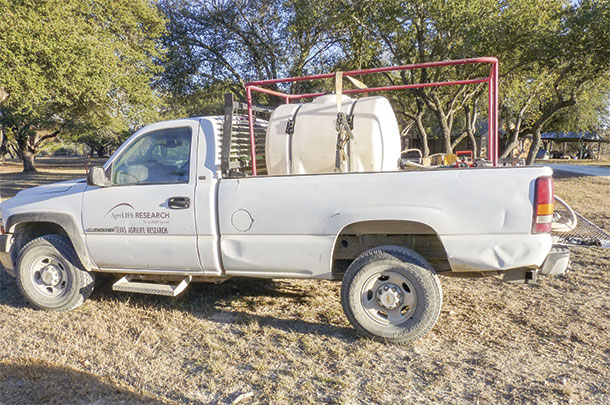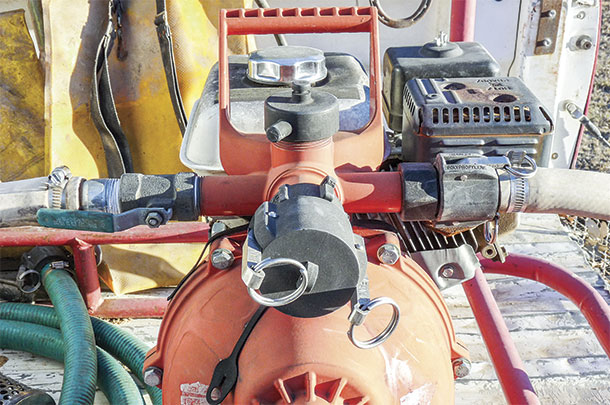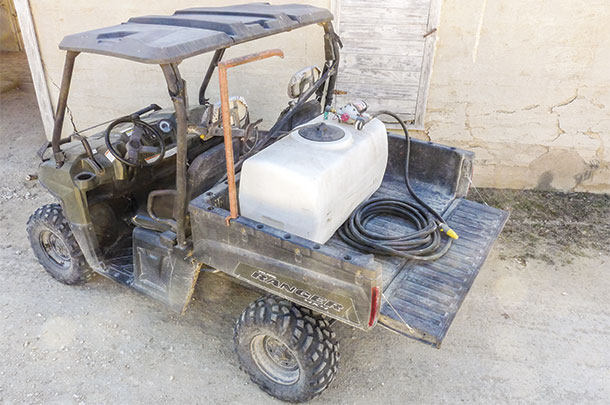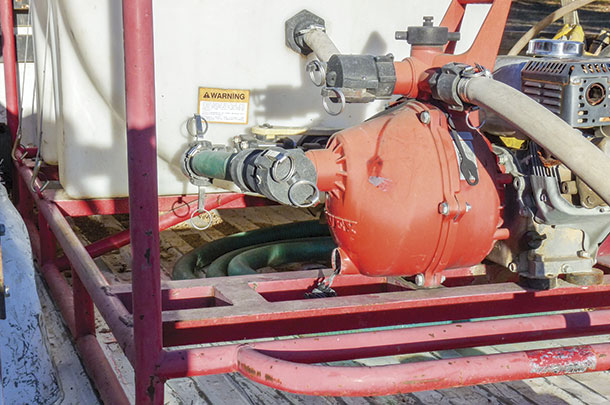Having to wait 20 minutes or more for an ambulance or firetruck can mean a loss of life or homestead. Preventing a fire from starting, suppressing a prescribed fire or protecting structures from wildfire can all be accomplished using a skid-mounted sprayer.
Sprayers can be purchased or built for a reasonable cost, using materials and equipment readily available. In this article, I would like to talk about things I have learned about building and using such sprayers over the years. Keep in mind that these are my opinions and are sometimes biased. They are, however, supported by experience gained through trial and error. I believe the information is reliable, even if there may be other options that will also provide similar results.
For the last 20 years, I have worked with a team of researchers using prescribed fire to help manage unwanted brush on rangeland. We have tried many different sprayers – some we purchased and some we built. There are many good, affordable ready-built spray rigs on the market that provide dependable protection.
Pumps and engines
The gasoline-engine-powered pumps use a variety of pump types, including centrifugal, diaphragm, roller and piston. All of these pump types can be useful for fire suppression. Because of my aforementioned bias, my preference leans toward centrifugal pumps for their easy maintenance and ability to discharge a large volume of water if necessary. However, having said that, I have used the other kinds of pumps with good results.
Numerous times, it has been beneficial to have a sprayer with much higher pressure than provided by a centrifugal pump. Also, many of the ready-made sprayers come with high-pressure pumps and not centrifugal pumps. Sometimes on the fire line, water sources are not always clean. Centrifugal pumps are more forgiving when less-than-clear water is running through them.
In my opinion, they are superior for firefighting because they can discharge more water at greater distances and with fewer working parts. Not all centrifugal pumps are the same, however. Make sure the pump you select can produce 80 to 150 pounds per square inch of pressure. Whatever type of pump and engine you decide on, the most important things are proper maintenance, protection from cold and proper filters to prevent damage.
Built with the end in mind
Prescribed burning or fire suppression can create a high-stress environment. I believe the simpler we can make the system, the more reliably it will function and the less stress it will add. A small, gasoline-powered sprayer (5 to 6.5 horsepower) and a water tank mounted to a metal skid that easily fits in a pickup bed may be the most useful tool to have on the farm or ranch (see Photo 1).

Not only can they be used for fire suppression, they can also fill water troughs, water trees, clean equipment and more. However, if you intend to use the unit for fire suppression, build it with that in mind or you’ll likely be disappointed.
A pump used to water trees or a garden that doesn’t develop enough pressure to spray water 50 to 60 feet, won’t be useful on a fire. Or a tank so large or a frame so heavy it taxes the vehicle and takes three or four men to move is not practical.
While I admire ranchers who believe in using one piece of equipment for different jobs, I would caution you not to use your sprayer for pesticide application. Besides the obvious health hazard of using equipment that had pesticide in it around people, many of the seals in pumps made to spray water are not compatible with chemicals and will break down over time.
Improvements
The most inexpensive units will be those with the simplest capabilities. A unit that will only spray water will cost less than one that can also draft water from an external source to refill it or another unit. Increasing capabilities increases the level of complexity, which can also mean more can go wrong.
Plumbing a spray rig can sometimes be made easier by spending a bit more for a pump with a specialized discharge manifold. This allows attaching two, 1-inch discharge hoses as well as a 1.5-inch discharge hose for filling other tanks more quickly. This manifold saves fittings, but more importantly, it saves space (see Photo 2).
 Technology for water pumps and gasoline engines has improved in the last 20 years with smaller, more efficient units. The performance from pumps that once weighed 100 pounds can now be had in pumps weighing 31 pounds. Less weight means they are more manageable.
Technology for water pumps and gasoline engines has improved in the last 20 years with smaller, more efficient units. The performance from pumps that once weighed 100 pounds can now be had in pumps weighing 31 pounds. Less weight means they are more manageable.
This means there is less stress on the vehicle carrying the sprayer and the operator moving and using it. They are also more reliable, quieter, easier to start and maintain. This translates to more confidence on the fire line.
Great advances have also been made in 12-volt, electric-powered pumps. There are now 3- to 7-gallon-per-minute diaphragm pumps with pressure-controlled shut-off switches that are perfect for carrying on an ATV using a 20- to 60-gallon tank, depending on the vehicle size (Photo 3).

These make the perfect “fast attack” vehicle for use on prescribed fires or mopping up after a prescribed burn. As good as these units are, however, both gas and electric, there are limitations and even good equipment needs to be supported by sound judgment.
To sum up, if you are building a sprayer, save weight wherever you can. Most poly tanks are self-supporting, so extra-heavy frame construction is not needed. Polypropylene fittings and schedule 80 PVC are very good and much lighter than metal (Photo 4).

Good-quality poly tanks are worth the money and will last for years, but don’t install a tank that will hold more water than your vehicle will easily carry (water weighs 8.3 pounds per gallon). Metal-framed skids can be made with 14-gauge or 16-gauge tubing. It is also a good idea to include at least one rail, high enough for the operator to use as a grab bar for safety while the vehicle is in motion (Photo 1).
Safety on the farm or ranch is always a concern. Using current technology, some imagination and parts that are readily available, it is possible to provide an extra level of safety for you, your family and those you work with. ![]()
PHOTOS: Photos by Nick Garza.
Nick Garza is a senior research associate with AgriLife Research – Sonora. Email Nick Garza.






